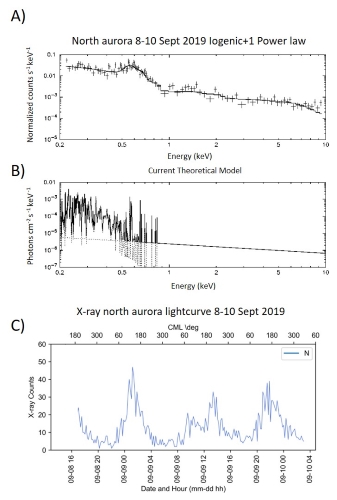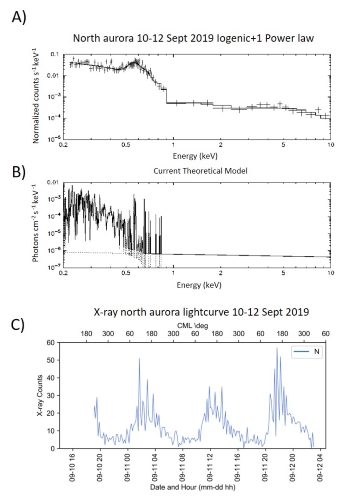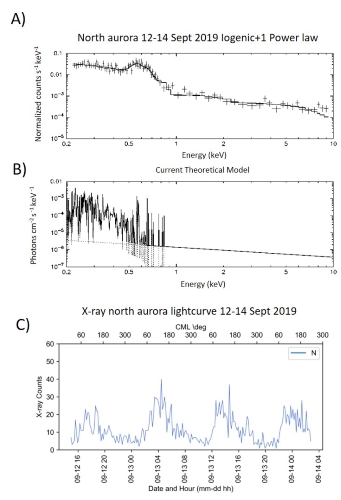Searching for signatures of tail reconnection and plasma injection events in Jupiter’s X-ray aurora
- 1University College London, Mullard Space Science Laboratory, Space and Climate Physics, Dorking, UK (affelia.wibisono.18@ucl.ac.uk)
- 2The Centre for Planetary Science at UCL Birkbeck, London, UK
- 3Frontier Research Institute for Interdisciplinary Sciences Tohoku University, Sendei, Japan
- 4Laboratoire de Physique Atmosphérique et Planétaire, Université de Liège, Liège, Belgium
- 5Southwest Research Institute, San Antonio, TX, USA
- 6University of Texas at San Antonio, San Antonio, TX, USA
- 7Key Laboratory of Earth and Planetary Physics, Institute of Geology and Geophysics, Chinese Academy of Sciences, Beijing, China
Jupiter’s UV and X-ray aurorae were first discovered in 1979 by Voyager 1 and the Einstein Observatory, respectively. The auroral morphology comprises an oval ring of UV and high energy, or “hard”, X-rays and both emissions are produced by the same population of energetic electrons (Branduardi-Raymont et al., 2008). As the electrons precipitate into the gas giant’s atmosphere, they can excite molecular and atomic hydrogen that will then release UV photons while returning back to the ground state. The electrons can also emit bremsstrahlung radiation in the X-ray waveband as they are slowed and deflected by the molecules in the atmosphere. Within this oval is a second source of X-ray emissions with lower energies, as well as diffuse UV emissions. These “soft” X-rays are the result of ions charge exchanging with neutrals in Jupiter’s atmosphere. Observational and theoretical studies seem to favour an iogenic origin for these ions (e.g. Wibisono et al., 2020; Cravens et al., 1995), however, there are instances where the spectrum is better fit by the inclusion of solar wind ions (Dunn et al., 2020). The ion emissions also often pulse with periods of tens of minutes (e.g. Gladstone et al., 2002; Jackman et al., 2018).
The aurora in both wavebands is responsive to changing conditions inside and outside of Jupiter’s magnetosphere (Grodent et al., 2018). For example, the dawnside main emission of the UV aurora is dim and thin when the magnetosphere is undisturbed and contains very little plasma. The appearance of dawn storms, or short-lived brightenings in the dawnside main oval emission, is associated with tail reconnection events (Yao et al., in review) and is usually accompanied by a distinct enhancement equatorward of the main emission towards the dusk sector. This feature is caused by strong injections of magnetospheric plasma (Mauk et al. 2002). A solar wind compression results in a very bright and defined main oval in the dawn sector and bright poleward emissions in the dusk sector. Previous studies have shown that the X-ray aurora brightens during solar wind compressions but it can also do so during intervals of quiet solar wind, possibly suggesting control by sources internal to the magnetosphere (Dunn et al., 2020). However, signatures in the X-rays that point to mass loading and injection events having happened have not yet been identified.
Juno’s 22nd perijove on 12 September 2019 was supported by remote observations of Jupiter from XMM-Newton, Chandra, the Hubble Space Telescope and Hisaki. XMM-Newton undertook an unprecedented 405 ks-long campaign between 8 and 14 September 2019 and recorded the X-ray aurora changing its behaviour throughout this time (see Figures 1-3). The spacecraft made 3 orbits around the Earth during this time hence why there are 3 sets of spectra and lightcurves and the gaps in the lightcurves are due to XMM-Newton perigee passages. Images of the UV aurora from Hubble show dawn storms and injection events at least twice during those six days. Hisaki data also show that the Io Plasma Torus and EUV aurora were responding to internally driven processes around this time. Juno’s location at local midnight allowed it the perfect opportunity to confirm whether tail reconnection had happened and detect plasmoids that may have been shot back towards Jupiter. We present our findings of how these mass loading and magnetospheric plasma injection events leave their marks on the timing and spectral properties of the X-ray aurora.

Figure 1: XMM-Newton EPIC-pn spectra (crosses on panel A) and EPIC light travel time shifted lightcurves (panel C) of Jupiter’s X-ray aurora from 8-10 September 2019. The spectrum is best fitted with an atomic charge exchange model for an iogenic (sulphur and oxygen) plasma population and a power law continuum. Panel B shows the theoretical spectra of the models used which were then convolved with the instrument response to give the black lines that are plotted over the data in panel A. The aurora is very bright during the first XMM-Newton orbit with a high flux above 1 keV in the spectrum and the corresponding lightcurve shows some regular pulsations.

Figure 2: Same format as Figure 1 but for 10-12 September 2019. There is an increased amount of soft X-ray emissions in the second orbit with very dim hard X-ray emissions. Bright flares were emitted at ~02:00 and ~22:00 UT on 11 September and strong quasi-periodic pulsations in the aurora occurred during much of this orbit.

Figure 3: Same format as Figure 1 but for 12-14 September 2019. The spectrum for the final orbit now illustrates a decreased amount of soft X-ray emissions and brightened hard X-ray emissions; the lightcurve shows that the aurora had stopped pulsating.
References
Branduardi‐Raymont, G. et al. (2008), Spectral morphology of the X‐ray emission from Jupiter's aurorae, J. Geophys. Res., 113, A02202, doi:10.1029/2007JA012600
Cravens, T.E. et al. (1995), Auroral oxygen precipitation at Jupiter, J. Geophys. Res., 100 (A9), 17153– 17161. doi:10.1029/95JA00970.
Dunn, W.R. et al. (2020). Comparisons between Jupiter's X‐ray, UV and radio emissions and in‐situ solar wind measurements during 2007. Journal of Geophysical Research: Space Physics, 125, e2019JA027222. https://doi.org/10.1029/2019JA027222
Gladstone, G.R. et al. (2002). A pulsating auroral X-ray hot spot on Jupiter. Nature, 415, 1000–1003. https://doi.org/10.1038/4151000a
Grodent, D. et al. (2018). Jupiter's aurora observed with HST during Juno orbits 3 to 7. Journal of Geophysical Research: Space Physics, 123, 3299– 3319. https://doi.org/10.1002/2017JA025046
Jackman, C.M. et al. (2018). Assessing quasi‐periodicities in Jovian X‐ray emissions: Techniques and heritage survey. Journal of Geophysical Research: Space Physics, 123, 9204– 9221. https://doi.org/10.1029/2018JA025490
Mauk, B.H. et al. (2002). Transient aurora on Jupiter from injections of magnetospheric electrons. Nature, 415, 1003-1005. https://doi.org/10.1038/4151003a
Wibisono, A.D. et al. (2020). Temporal and spectral studies by XMM‐Newton of Jupiter's X‐ray auroras during a compression event. Journal of Geophysical Research: Space Physics, 125, e2019JA027676. https://doi.org/10.1029/2019JA027676
Yao, Z.H. et al. (in review). Reconnection and Dipolarization Driven Auroral Dawn Storms and Injections, J. Geophys. Res. Space Physics
How to cite: Wibisono, A., Branduardi-Raymont, G., Coates, A., Dunn, W., Haythornthwaite, R., Kimura, T., Grodent, D., Allegrini, F., Ebert, R., and Yao, Z.: Searching for signatures of tail reconnection and plasma injection events in Jupiter’s X-ray aurora, Europlanet Science Congress 2020, online, 21 September–9 Oct 2020, EPSC2020-468, https://doi.org/10.5194/epsc2020-468, 2020

